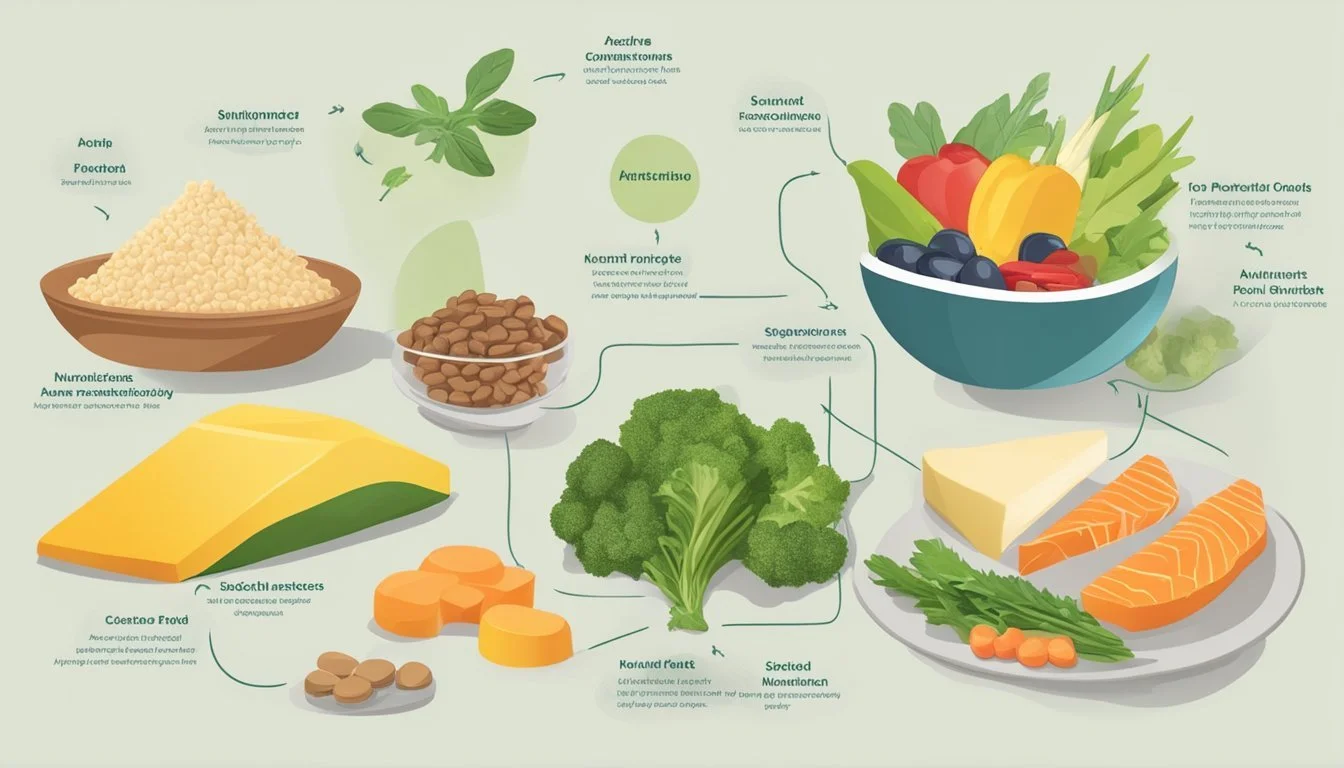Keto Diet and Joint Health
Uncovering the Connection
The ketogenic diet, commonly known as the keto diet, emphasizes high fat intake, moderate protein, and very low carbohydrate consumption. Proponents of the diet suggest that it may have several health benefits, including potential improvements in joint health. By drastically reducing carbohydrates to typically less than 50 grams daily, the body enters a state of ketosis, where it burns fat for energy instead of glucose. This metabolic shift not only aids in weight loss but may also reduce inflammation, a key culprit in joint pain and dysfunction.
Clinical observations and some studies indicate that overweight individuals experiencing joint pain may find relief through the keto diet, which can help shed excess body weight that places stress on the joints. Furthermore, the anti-inflammatory effects associated with the diet could lead to a decrease in swelling and discomfort in inflammatory arthritis. Such a reduction in systemic inflammation aligns with the fundamental goals of an anti-inflammatory diet, which is to support overall joint health.
While there is growing interest in the keto diet's effects on joint health, it is important to approach this dietary pattern with careful consideration of its potential impacts on overall health. The emphasis on fats over carbohydrates significantly alters the standard nutritional balance, and therefore, individuals must ensure that they still meet their essential nutritional needs while on the diet. As research continues to explore the long-term effects of the ketogenic diet on various aspects of health, including joint health, individuals should consult with healthcare professionals before making significant dietary changes, especially those with existing health conditions.
Understanding the Keto Diet
The ketogenic diet is a scientifically recognized approach to weight management and metabolic health, focusing on macronutrient regulation and the induction of ketosis.
Definition and Principles of Ketosis
Ketosis is a metabolic state in which the body primarily burns fat for energy instead of carbohydrates. This process happens when carbohydrate intake is dramatically reduced to usually less than 50 grams per day, prompting the liver to convert fat into fatty acids and ketone bodies. The latter becomes the main energy source for the body and brain. This shift from glucose to ketones for energy is the core principle of the ketogenic or keto diet.
Differences Between Keto and Other Diets
Diet Carbohydrate Intake Fat Intake Protein Intake Primary Energy Source Ketogenic Very Low (< 50g/day) High (70-75%) Moderate (20%) Fats (Ketones) Low-Carb Low (50-130g/day) Varies Varies Fats and Proteins Typical Western High Moderate to High Moderate Carbohydrates
The ketogenic diet is distinct from other low-carbohydrate diets due to its drastic reduction of carb intake and the specific macronutrient ratio that prioritizes a high-fat intake. This is different from standard low-carb diets that do not always lead to ketosis. The ketogenic diet's unique nutrient composition supports a metabolic shift toward fat utilization and ketone production.
The Connection Between Diet and Joint Health
Diet is integral to managing joint health, particularly in the context of inflammation and arthritis. Specific dietary strategies can influence joint pain and health outcomes.
Influence of Nutrition on Joint Pain and Inflammation
Nutrition has a significant impact on joint pain and inflammation. An anti-inflammatory diet may help ease joint discomfort and swelling. Certain diets high in refined sugars and saturated fats can exacerbate inflammation, contributing to joint pain and the progression of diseases such as rheumatoid arthritis. On the contrary, foods rich in omega-3 fatty acids and antioxidants can support the reduction of inflammation.
Specific Diets and Their Impact on Joint Health
Ketogenic Diet: Characterized by high-fat, moderate-protein, and low-carbohydrate intake, the ketogenic diet is known to reduce the NLRP3 inflammasome, an immune system driver of inflammation, thus potentially providing relief from inflammation associated with joint pain and rheumatoid arthritis. A standard ketogenic diet typically comprises about 70-75% fats, 20% proteins, and 5-10% carbohydrates, which shifts the body's metabolism from burning sugar to burning fat.
Research suggests that a ketogenic diet can have benefits for cardiovascular health and may help manage symptoms in inflammatory arthritic conditions, but it's essential to consider the diet's influence on bone health and maintain a balanced nutrient intake to avoid potential adverse effects.
Keto Diet and Its Role in Managing Arthritis
Arthritis sufferers often seek dietary approaches to improve their symptoms, with the ketogenic diet gaining attention for its potential anti-inflammatory benefits.
Ketogenic Diet as a Potential Anti-Inflammatory Agent
The ketogenic diet, characterized by low carbohydrate and high fat intake, may have anti-inflammatory properties that can benefit individuals with arthritis. By limiting carbohydrates, the body enters a state of ketosis, which can lead to the production of ketone bodies like β-hydroxybutyrate (BHB). BHB has been shown to inhibit inflammatory responses by affecting pathways like the NLRP3 inflammasome. Foods rich in poly- and monounsaturated fats, such as fish, walnuts, and olive oil, typically included in the ketogenic diet, could further support the reduction of inflammation.
Scientific Research on Keto and Arthritis
Research exploring the intersection of the ketogenic diet and arthritis has yielded promising findings. Studies have indicated that adherence to a ketogenic diet can result in weight loss and improved control of metabolic and cardiovascular diseases, which are critical since obesity and poor metabolic health can exacerbate inflammatory arthritis. Additionally, the ketogenic diet may alter immune system function, offering potential benefits for autoimmune diseases, with anecdotal evidence suggesting a reduction in joint pain and improved symptom control in rheumatic conditions like rheumatoid arthritis. However, the specific mechanisms by which the ketogenic diet impacts these conditions remain a focus for ongoing study.
Weight Management Through Ketogenic Diet
In the realm of diets focused on weight management, the ketogenic diet, often referred to simply as "keto," commands significant attention for its approach to high-fat and low-carbohydrate consumption which fosters weight loss and may attenuate joint pain by reducing obesity-related stress on joints.
Keto Diet and Weight Loss Correlation
The ketogenic diet induces a metabolic state known as ketosis, wherein the body utilizes fat for energy in place of carbohydrates. This shift in metabolism promotes the burning of body fat, which can lead to weight loss. Studies show that alongside weight loss, individuals may experience reduced insulin resistance, which is beneficial for metabolic health. The diet's restriction of carbs leads to a decrease in insulin levels, which in turn reduces fat storage.
Initial weight loss is often rapid, as the body depletes its glycogen stores and loses water weight.
Sustained ketosis has been associated with continued weight loss over longer periods.
Notably, the ketogenic diet encourages home-cooked meals and increases dietary awareness, factors that contribute to consistent weight management.
Effects of Weight Loss on Joint Health
Weight loss, particularly in individuals suffering from obesity, significantly lessens the burden on joints, which can mitigate joint pain and improve overall joint health. The reduction in body fat from following a ketogenic diet has a direct correlation to decreased mechanical stress on the weight-bearing joints.
Each pound of weight loss can result in a fourfold reduction in the load exerted on the knee per step during daily activities.
Lower body weight is linked to reduced inflammation, potentially reducing the risk of inflammatory arthritis.
By adhering to the principles of the ketogenic diet, individuals may not only see a decrease in obesity but also enjoy an array of health benefits including improved joint health.
Nutritional Considerations for Keto Dieters
The nutritional balance of a ketogenic diet requires careful planning to ensure the dieter receives essential nutrients while adhering to the correct macronutrient distribution. Macronutrients must be carefully calibrated, and certain nutrients may need to be supplemented to maintain health and wellness.
Macronutrient Distribution in Keto
On a ketogenic diet, the macronutrient distribution is notably different from that of a standard diet. It is predominantly:
High in fats: Approximately 70-80% of daily caloric intake.
Moderate in proteins: Roughly 20-25% to maintain muscle mass without disrupting ketosis.
Low in carbohydrates: Limited to 5-10% to facilitate the metabolic state of ketosis.
The typical low carb intake necessitates the elimination or substantial reduction of grains and other high-carb foods. In contrast, sources of healthy fats, such as avocados, nuts, and seeds, are emphasized.
Essential Nutrients and Supplements on Keto
Individuals on a ketogenic diet must ensure they receive an adequate supply of essential nutrients which may otherwise be limited due to dietary restrictions.
Vegetables: Non-starchy vegetables are important for fiber and micronutrients. Options include leafy greens, broccoli, and zucchini.
Protein: Quality sources like meats, fish, eggs, and some dairy provide essential amino acids and omega-3 fatty acids.
Fat: A focus on poly- and monounsaturated fats, including those from olive oil, fish, and nuts, supports joint health and inflammation reduction.
Vitamin C and other vitamins: Since fruit intake is limited, vegetables high in vitamin C or supplementation may be necessary.
Essential Nutrients: A multivitamin or specific supplements like magnesium, sodium, potassium, and calcium can be crucial for addressing potential deficits.
Nutritional supplements can assist in maintaining equilibrium, especially for nutrients less abundant in a strict ketogenic meal plan. In all cases, a diet should be personalized to meet individual nutritional needs and support overall health.
Health Considerations and Medical Guidance
Adopting the ketogenic diet for joint health necessitates careful consideration of individual health conditions and medical history. The following subsections outline the importance of consulting healthcare providers and highlight specific contraindications and monitoring requirements for those considering the keto diet.
Consulting with Healthcare Providers
Individuals considering the ketogenic diet should initially consult with a healthcare provider. A doctor can provide personalized advice on whether this high-fat, low-carbohydrate diet is suitable based on one's health status and goals. The diet can impact various health aspects, including cholesterol levels and heart health. It is especially important for those with pre-existing conditions such as liver or kidney disease, heart disease, or high blood pressure to seek medical advice before starting the diet.
Contraindications and Monitoring for Keto Dieters
There are specific contraindications that require careful attention for keto dieters:
Liver and Kidney Health: The ketogenic diet places additional stress on the liver and kidneys due to the increased metabolism of fats. This can exacerbate existing liver and kidney conditions.
Heart Disease: Despite potential benefits in weight loss and metabolic health, the diet’s high fat intake might affect cholesterol levels. Persons with heart disease or a history of stroke should monitor their cholesterol closely when on a ketogenic diet.
Cancer: The diet's influence on cancer is not well established and could interact with cancer medications.
Medications: Those on medication for blood pressure or other chronic conditions should have their dosages monitored and adjusted as the diet can alter the efficacy of certain medications.
Regular monitoring by a healthcare provider is crucial to ensure the diet does not lead to adverse health effects. Monitoring should include regular checks on cholesterol levels, kidney and liver function tests, and assessment of any changes in medication requirements.
Managing Side Effects and Risks of Keto Diet
The keto diet, while beneficial for weight loss and certain health conditions, can also come with side effects that need careful management. Awareness and proactive strategies are crucial to mitigate common symptoms like keto flu and to prevent potential long-term health risks.
Keto Flu and Mitigating Symptoms
The initiation phase of a ketogenic diet often leads to a group of symptoms known as the keto flu. Symptoms such as fatigue and nausea can be distressing and may hinder daily activities. To manage these symptoms effectively:
Stay Hydrated: Increase water intake to combat dehydration, a common contributor to keto flu symptoms.
Balanced Electrolytes: Ensure sufficient intake of key electrolytes like sodium, potassium, and magnesium, which may be lost at higher rates.
Adequate Rest: Prioritize sleep to allow the body to adjust to the new high-fat diet.
Gradual Transition: Slowly reduce carbohydrate intake rather than an abrupt shift to ease the body into ketosis.
By following these steps, individuals can often alleviate the discomfort associated with the keto flu and improve their overall experience with the diet.
Long-Term Health Risks and Prevention
A ketogenic diet's long-term adherence can pose health risks, necessitating preventative measures:
Liver Health: High-fat intake can sometimes lead to liver steatosis (fatty liver). Managing portion sizes and choosing healthy fats are steps one can take to protect liver health.
Kidney Function: Monitor for signs of kidney stones and maintain hydration to help prevent their formation.
Cardiovascular Concerns: Be mindful of the types of fats consumed; prioritize unsaturated fats like those from fish and olive oil to support heart health and reduce the risk of heart disease.
Nutritional Deficiencies: A strict keto diet may result in deficiencies in certain vitamins. A balanced approach with attention to micronutrient intake is essential.
While the ketogenic diet may be effective for certain individuals, it's imperative to consider and address these potential risks. Regular monitoring and consultation with healthcare providers are recommended to ensure that the diet is safe and beneficial for the individual's unique health circumstances.
Keto Diet Variations and Alternatives
Understanding the nuances of different dietary approaches is crucial for tailoring nutrition to individual health needs, particularly when considering the influence of diet on joint health.
Modified Keto Diets for Specific Needs
The ketogenic diet is adaptable, allowing for modifications to suit diverse health requirements. While the traditional ketogenic diet is high in fat, representing typically 70-75% of daily caloric intake, alternatives such as the high-protein ketogenic diet may up the protein content, reducing fat slightly to accommodate this change.
Standard Ketogenic Diet (SKD): High in fat (~70%), moderate in protein (~20%), low in carbohydrates (~10%)
High-Protein Ketogenic Diet: Similar to SKD, but includes more protein (~35%), less fat (~60%)
Intermittent fasting, paired with ketogenic eating patterns, has gained popularity. It often involves short periods of fasting coupled with windows of ketogenic eating, potentially enhancing metabolic flexibility and fat loss.
Comparing Mediterranean and Low-Fat Diets
When considering joint health, some may opt for dietary patterns rich in fruits, whole grains, and less processed foods—hallmarks of the Mediterranean diet. Unlike ketogenic diets, the Mediterranean diet includes a moderate amount of carbohydrates and is high in unsaturated fats, with limited red meat (What wine goes well with red meat?) consumption.
Mediterranean Diet: Emphasizes fruits, vegetables, whole grains, legumes, and olive oil; includes moderate seafood and poultry; limits red meat and alcohol.
Low-fat diets contrast with the ketogenic approach by restricting fat intake to typically 20-30% of daily calories, potentially benefiting cardiovascular health, but may be less effective at promoting substantial weight loss than ketogenic options.
Low-Fat Diet: Focuses on fruits, vegetables, whole grains, and lean proteins; reduces intake of all fats, particularly saturated fats.
Incorporating exercise into a dietary plan is essential for joint health, regardless of dietary preference, as it strengthens muscles and improves overall bodily function.
Lifestyle and Physical Activity on Keto
Lifestyle choices, like incorporating regular exercise and maintaining overall wellness, play a critical role in the effectiveness of a ketogenic diet, especially when considering joint health and physical function.
Exercise and Keto Adaptation
When individuals begin a ketogenic diet, their bodies undergo a transition to reach a state of ketosis, where fat is used as the main energy source, instead of carbohydrates. This metabolic state can be influenced positively by exercise, which can help to expedite the adaptation process. Initially, there may be a noticeable decrease in energy and physical performance. However, as the body adapts, most individuals experience a return to normal or even enhanced physical function. To support this adaptation:
Begin with low-intensity exercises: Such as walking or yoga.
Gradually increase intensity: As the body adapts, incorporate more strenuous activities like strength training or high-intensity interval training (HIIT).
It's worth noting that regular exercise can aid in weight loss and improve blood sugar control, both of which are common goals of the ketogenic diet.
Integrating Keto with Overall Wellness
A ketogenic lifestyle goes beyond diet alone; it encapsulates a holistic approach to wellness that includes managing stress, getting adequate sleep, and maintaining social connections. Joint pain, a concern for many on a ketogenic diet, can be managed through a well-rounded approach that encompasses dietary choices and lifestyle habits.
To integrate keto with overall wellness, one should consider:
Regular physical activity: To keep joints limber, reduce stiffness and pain.
Electrolyte management: Ensuring a balance of electrolytes can prevent cramps and other common issues linked to joint pain on a keto diet.
By focusing on these lifestyle factors, individuals can better manage their joint health while reaping the benefits of a ketogenic diet.
Recipes and Meal Planning
When embarking on a keto diet for joint health, it's crucial to consider the preparation of keto-friendly foods and the construction of balanced meals that support joint health while adhering to the low-carb, high-fat dietary principles.
Keto-Friendly Foods and Preparation
Keto diets revolve around high-fat, moderate-protein, and low-carbohydrate foods. Proteins like red meat and tuna (What wine goes well with tuna?) serve as staples, providing essential nutrients without excess carbs. When preparing vegetables, one should opt for leafy greens and other non-starchy options such as broccoli (how long does broccoli last?) and cauliflower.
Dairy products, rich in fat, such as cheese and full-fat yogurt, can be included but should be consumed in moderation to maintain a balanced diet. Fruits, although generally high in natural sugars, can be part of a keto diet in small quantities; examples include berries like strawberries and blueberries.
Water intake is vital on a keto diet, and individuals should ensure adequate hydration. High water-content vegetables can also aid in maintaining hydration. Below is a list of common keto-friendly foods:
Food Group Examples Protein Red meat, poultry, fish (tuna, salmon), eggs Vegetables Spinach, kale, broccoli, cauliflower, zucchini Fruits Avocado, berries (strawberries, raspberries) Dairy Cheese, butter, full-fat yogurt Fats Olive oil, coconut oil, nuts, seeds
Creating Balanced Keto Meals
Creating balanced keto meals requires attention to macronutrient distribution: ample fats, moderate protein, and minimal carbs are key. A balanced keto meal might include a palm-sized portion of protein such as red meat or tuna, a generous helping of vegetables like spinach or broccoli, and a source of healthy fats, for instance, a dressing made with olive oil or a sprinkle of seeds.
The inclusion of variety ensures adequate nutrient intake and can help in maintaining joint health. People should prioritize low-carb options and integrate sufficient vegetables and fruits for fiber and micronutrient needs. Adequate protein is important for muscle and joint support without exceeding the body’s requirement which can vary depending on activity level.
Here is an example of a balanced keto meal:
Protein: Grilled chicken breast
Vegetables: Sautéed kale and mushrooms
Fat: Olive oil dressing
Dairy: A sprinkle of feta cheese
Fruit: A handful of blackberries
Remember, the key to sustaining a keto diet is to keep up with diverse and appetizing recipes that fit within the required macronutrient range, while also supporting your joint health and overall well-being.
Personal Stories and Community Support
In exploring the keto diet's impact on joint health, numerous individuals have come forward to share their experiences. They often discuss how adopting a ketogenic lifestyle has contributed to the alleviation of joint pain, particularly in cases of inflammatory arthritis.
Sharing Experiences with Keto and Joint Health
Personal anecdotes often serve as a source of encouragement for those considering keto for joint health. For some, incorporating this high-fat, low-carb diet has led to a marked reduction in the discomfort associated with joint conditions. The keto diet's alleged anti-inflammatory effect is a recurring theme in such stories, with individuals reporting less joint pain following dietary adjustments. A common breakfast includes simple keto-friendly options such as scrambled eggs with cheese and avocado, while lunch might feature inventive low-carb takes like a "chaffle" or turkey club cheese wrap.
Online Resources and Support Groups
The rise of the ketogenic diet has been accompanied by the proliferation of online communities that offer support, motivation, and a platform to exchange experiences. These forums and groups act as valuable resources for both newcomers and seasoned keto adherents. They offer:
Success Stories: Inspirational accounts of weight loss and health improvements that often include references to improved joint health and decreased symptoms of arthritis.
Dietary Guidance: Practical advice on managing macronutrient ratios to stay within the ketogenic framework, with an emphasis on maintaining carbohydrates below 50 grams per day.
Motivation and Accountability: Opportunities for members to share their progress and challenges, fostering an environment of support that can be especially beneficial for those tackling chronic joint issues.
Health Resources: Links to scientific studies and expert opinions that provide evidence-based information on the diet's mechanisms and potential benefits.
These digital platforms are integral in building a sense of community, where individuals come together over shared goals and experiences, finding inspiration and guidance in their journey towards better joint health and overall well-being.








